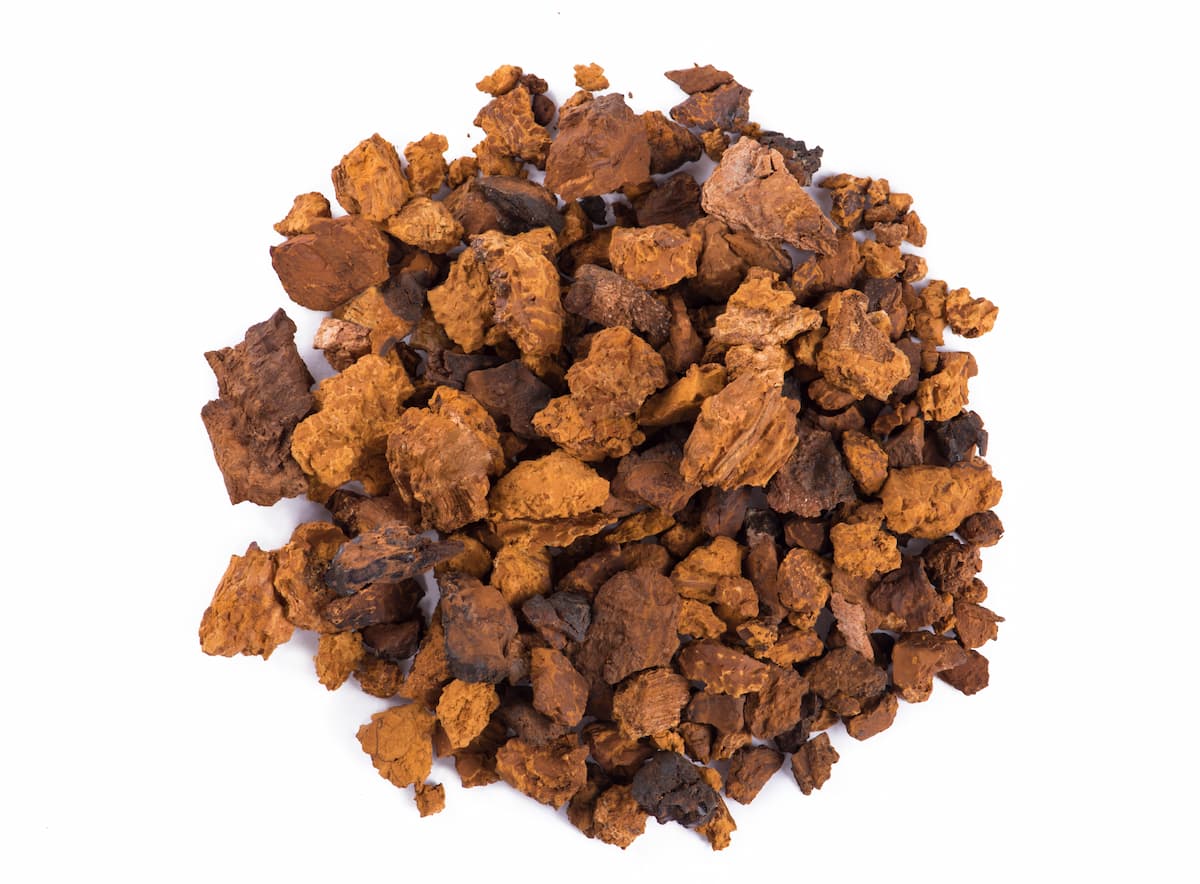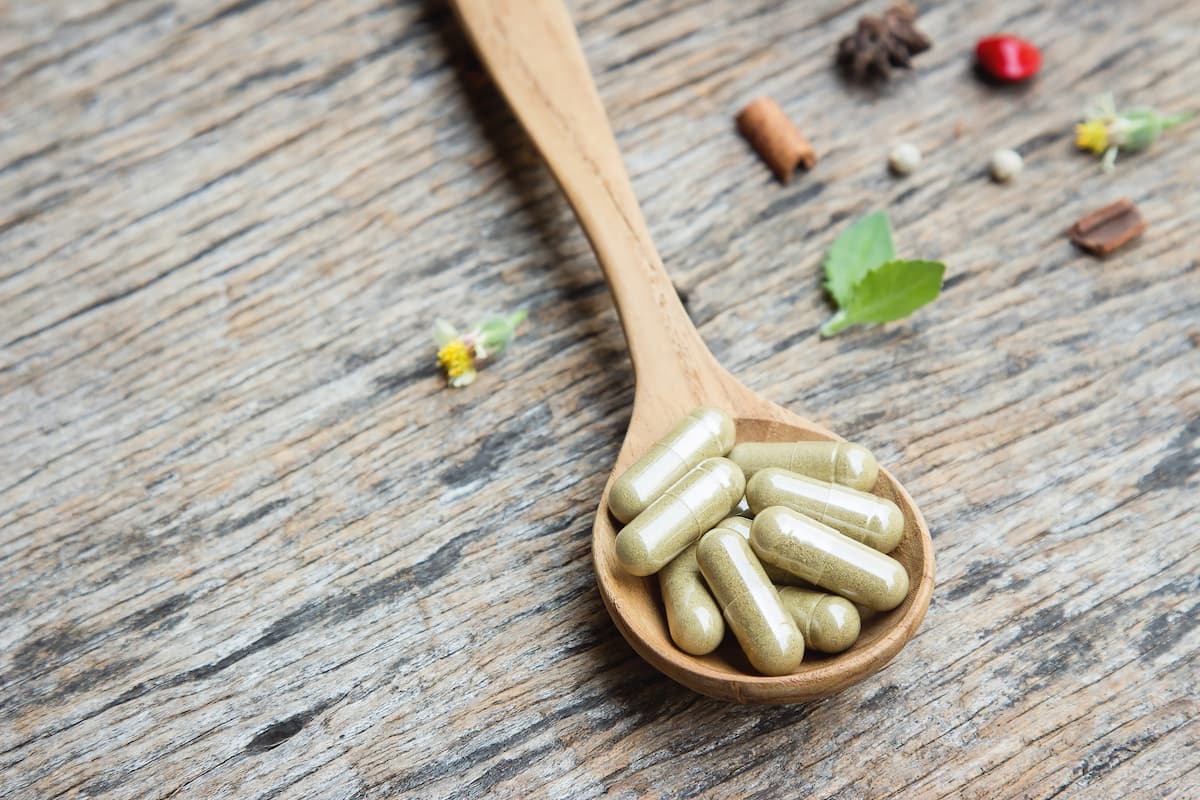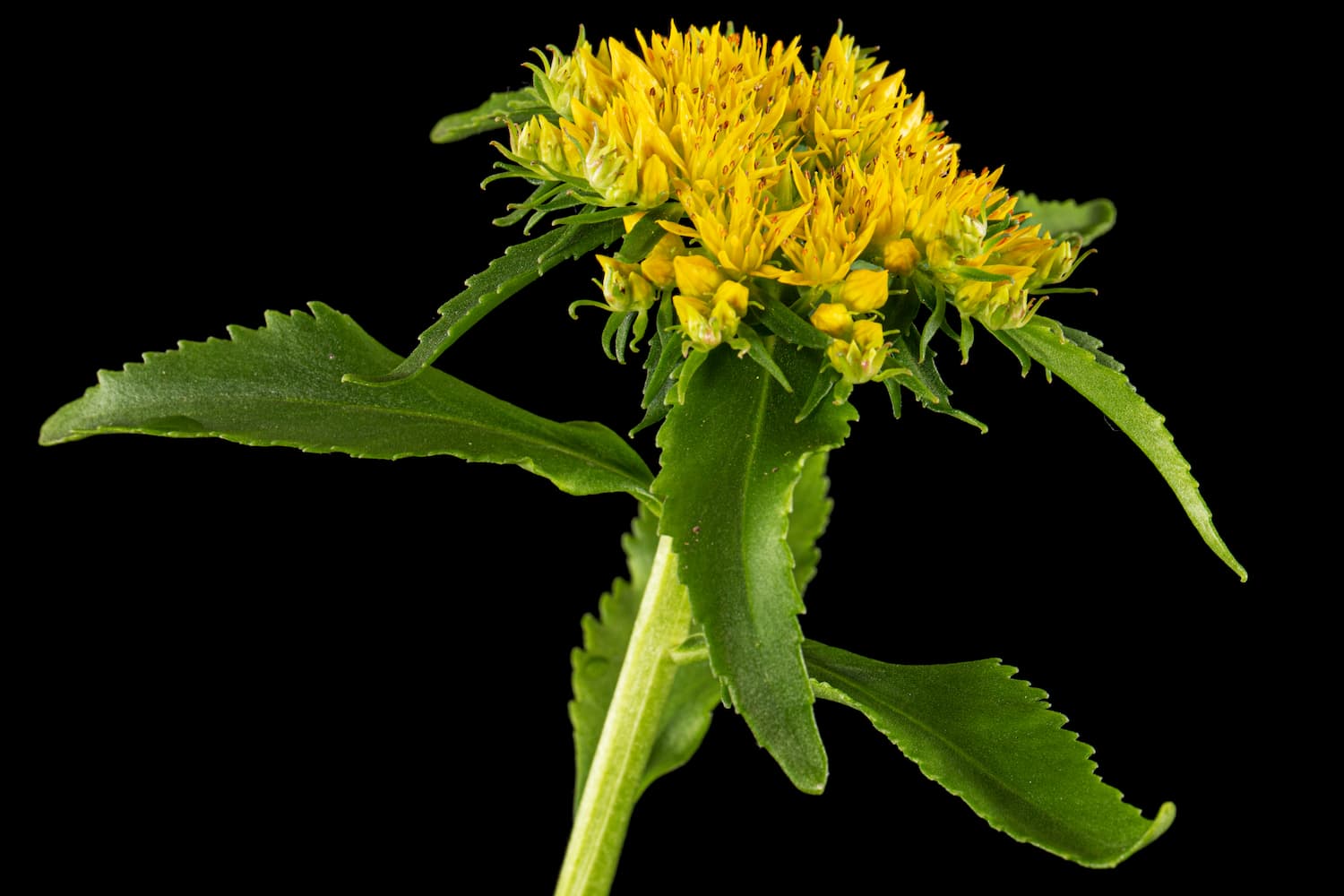Chaga mushroom - properties, what it helps, contraindications
The chaga fungus - to some a destroyer of birch trees, to others a health-promoting fungus. And what do the scientists say?


Learn more about our editorial process
.

Learn more about our editorial process
.

Learn more about our editorial process
.

Learn more about our editorial process
.
Why you can trust us
Articles on Natu.Care are written based on scientific research, data from government websites and other reliable sources. The texts are written in cooperation with doctors, nutritionists and other health and beauty experts. Articles are reviewed before publication and during significant updates.
.Learn more about our editorial process
.Information about advertisements
Content on Natu.Care may contain links to products from the sale of which we may receive a commission. When creating content, we adhere to high editorial standards and take care to be objective about the products discussed. The presence of affiliate links is not dictated by our partners, and we select the products we review ourselves completely independently.
.Learn more about our terms and Conditions
.For some, a parasite and destroyer of birch trees. Well, and a nasturtium (it's really not a very pretty fungus). To others, a valuable source of antioxidants (and looks don't matter). And what do the third - scientists - say?
I asked Ilona Krzak, MSc in pharmacy, and together we dived into the subject from the medical jurnals to the mushroom itself.
From this article you will learn:
.- What the chaga mushroom is. .
- What properties it has. .
- What the scientific research suggests.
- What it does.
- How to use the chaga mushroom.
- How to use the chaga mushroom.
- How to choose the best chaga preparation. .
See also:
.Chaga - birch tumour. What is this fungus?
.Chaga (Latin) Inonotus obliquus) is known in Poland as the subbark spinneret, birch hornwort or birch bump. It is a species of fungus in the bristlecone family. It is a parasite that most often attacks birch trees. It forms a thick layer on them and causes the tree to dieand.
The name of the fungus is pronounced hard - 'chaga'. It is derived from тшак, tšak from the Komi language - the indigenous inhabitants of the Kama basin, west of the Urals .
.Compared to other adaptogenic mushrooms (e.g. soplosion), chaga is... exceptionally ugly (the author's opinion, but it's hard to disagree - editor's note). It is rare in Poland (avoid the area around the Białowieża Forest). Inhabitants of the north - Scandinavia, Russia and Canadaand - are mainly exposed to its fungal face.
.Chaga belongs to the group of so-called vital mushrooms. It has been used for thousands of years in traditional medicine (mainly in the East) to treat stomach ailments, boost the body's immune system and reduce inflammation .
Vital mushrooms is a term for a group of mushrooms that, because of the compounds they contain, have potential health benefits..
 .
.
Ilona Krzak Master of Pharmacy
Interesting facts
You could read about chaga in the Chinese Shen Nong Ben Cao Jing - herbal classic from the 3rd century BC. It is a collection of information on agriculture and medicinal plantsand.
In Poland, the chaga mushroom was theoretically used in phytotherapy as early as the 5th century AD and was very popular in the Middle Ages..
 .
.
Julia SkrajdaDietitian
.Chaga versus research
.The vast majority of scientific studies on the health effects of the chaga fungus have been conducted on animals or in vitro (so-called test-tube studies)and. This means that we know the potential of this plant, but we do not know exactly what effect it has on the human body.
You will say - after all, chaga has been used for thousands of years in Eastern folk medicine. Yes, but note that eastern countries are culturally and medically different from Europe, and traditions should not be a substitute for empirical research
In addition, Europeans have a different metabolism than, for example, Asians. All this influences the perceived effect of the fungus or simply... the placebo effect.
That is why it is good that scientists are checking folk messages about chaga in scientific studies. However, we need to be patient and wait for more qualitative studies with humans. In the meantime, we can marvel at the potential of chaga - who knows, maybe it will help you?
.Chaga - properties
.The chaga mushroom contains valuable bioactive compounds such asand:
- polysaccharides, including beta-glucans, .
- triterpenoids, .
- phenolic compounds, .
- melanin complexes, .
Thanks to their content, it exhibits several interesting properties that can support health.
Chaga mushroom potentially:
.Strengthens immunity
.Animal and in vitro studies suggest that chaga mushroom extract may reduce long-term inflammation and also fight harmful microorganisms. This may have a positive effect on the body's immunity. Chaga stimulates white blood cells, which are essential for fighting bacteria or virusesand.
White blood cells - leukocytes - play an important role in the immune system. They protect the body against various pathogens such as bacteria, viruses, fungi and even against cancer cells..
 .
.
Ilona Krzak Master of Pharmacy
Anti-inflammatory effects
.Chaga may prevent the production of harmful cytokines that cause inflammation and are associated with the onset of certain diseases. In a 2012 mouse study, extract from this mushroom reduced inflammation and intestinal damage by inhibiting inflammatory cytokinesand.
The role of cytokines is, among other things, to coordinate the body's immune response. An excess of cytokines can induce an adverse inflammatory response when the strength of the immune response is not adequate to the threat..
 .
.
Ilona Krzak Master of Pharmacy
Fighting cancer
.Several animal and test-tube studies have shown that chaga can prevent and slow the growth of cancer. This is likely due to its content of valuable antioxidants, which protect cells from oxidative stressand.
One of the valuable antioxidants it contains is triterpene. In vitro studies from 2016 suggest that a concentrated triterpene extract may help destroy cancer cells .
In 2016, a study was also conducted on mice with lung cancer. After 3 weeks of giving them chaga extract, the tumour shrank by 60% .
In another test-tube study, chaga extract prevented tumour growth in human liver cells. Similar results were observed in lung, breast, prostate and colon cancer cellsand.
Reduces cholesterol
.High cholesterol increases the risk of death from cardiovascular disease. It increases the likelihood of heart attack, stroke and atherosclerosisand. Chaga extract may have a beneficial effect on cholesterol levels, and again scientists are betting that this is due to antioxidants.
In a 2009 study, chaga extract was given to rats with high cholesterol for eight weeks. This mushroom lowered so-called bad LDL cholesterol, total cholesterol and triglycerides, and increased antioxidant levelsand.
In two other similar studies in mice from 2008 and 2017, it was observed that in addition to reducing LDL cholesterol, chaga increased so-called good HDL cholesterol .
.Reduces sugar levels
.Several scientific papers on rodents suggest that chaga has a positive effect on sugar-insulin metabolism. In a 2008 study on mice with diabetes, consumption of chaga mushroom for three weeks led to a 31% reduction in blood sugarand.
In a 2017 study on obese mice with diabetes, chaga extract was observed to lower blood sugar and insulin resistance compared to mice with diabetes that did not receive the mushroom .
.Antioxidant activity
.By containing beta-glucans, triterpenoids, phenolic compounds and melanin complexes, chaga can help reduce oxidative stress and protect against cellular damage caused by free radicals .
Free radicals, or unstable, highly reactive molecules, can attack and damage cells, proteins, fats or DNA. They accelerate the ageing of the body and put the body at risk of developing many diseases.
Free radicals are a major contributor to the ageing of the body.
Oxidative stress is an unfavourable condition for the body when there are too many free radicals and not enough antioxidants. This can promote the development of diseases such as neurodegenerative or cardiovascular diseases..
 .
.
Ilona Krzak Master of Pharmacy
Fighting ulcers
.Chaga, in combination with other herbs, has been used in traditional Eastern medicine to treat gastric and duodenal ulcersand.
In 2019, researchers tested this potential in rats with stomach ulcers. Feeding them chaga extract had a beneficial effect on combating the ailment. The researchers explain this by the presence of bioactive components that this mushroom containsand.
Reduces the severity of food allergies
.In in vitro studies, chaga mushroom has shown the potential to suppress the activity of immune cells responsible for the allergic reaction to certain foods. Inotodioland is likely responsible for this anti-allergic effect. In mouse studies, this compound reduced food allergy symptoms in rodents.
Chaga versus COVID-19
.In 2021 in silico studies (experiments using computer simulation), chaga showed potentially strong interactions with the SARS-CoV-2 virus.This is only a simulation, but it opens up an interesting prospect for researchers for further in vitro and in vivo studies.
Who is chaga for?
.The chaga mushroom is recommended for people who are concerned about:
- strengthen immunity, .
- support the cardiovascular system, .
- delay the body's ageing process, .
- regulate blood sugar levels, .
Which chaga is best?
.The best chaga mushroom products contain extract standardised for polysaccharide content (optimally 30%) and triterpenes and DER ( Drug Extract Ratio). This ensures that you know what you are consuming, of what quality and in what quantity. Unfortunately, without providing such information, there is a chance that you will end up with "hay".
Traditional plant medicine used chaga from birch trees, but in practice this fungus is now grown under controlled conditions and artificially extracted. It is a safer form for humans..
 .
.
Julia SkrajdaDietitian
.Recommended intake
.Dose chaga mushroom in the amounts recommended by the manufacturer. The usual daily serving of the extract is 500 to 1500 mg. Unfortunately, due to the small number of scientific studies involving humans, there are no reliable guidelines on the appropriate dose of chaga to achieve a therapeutic effect.
How to use chaga mushroom
.Which form is best?
.There are coffees, functional drinks, teas, dries, drops, tinctures and chaga mushroom capsules available on the market. Tailor the form to suit you - perhaps you want to start a new ritual during the day with an aromatic coffee? Capsules are convenient, a functional drink can make a cookie more enjoyable, and a tincture - like a tincture - warms and relaxes.
Drink in the morning or evening?
.Chaga is best taken in 2-3 servings per day e.g. in the morning, early afternoon and evening, so that the fungus has time to 'set up' in the body. Chaga does not have an adrenaline effect; it is neither stimulating nor sleep-inducing, so do not be afraid to consume it. However, if you take chaga with coffee, drink it at least six hours before bedtime.
When will I feel the effects?
You can feel the effects of chaga mushroom after about 4 weeks systematic use. Some things don't happen straight away, such as improved immunity or lowered blood cholesterol levels. The body has to get used to and utilise the valuable bioactive ingredients.
Chaga is not the type of ingredient whose effects can literally be seen. Observe how you endure autumn colds (perhaps there are fewer of them or they pass more quickly?). Test your cholesterol and sugar levels before you start taking the mushroom and after about 4-6 weeks.
How long can you take chaga?
.Scientific studies have tested the effects of chaga mushroom for 2-8 weeks (mainly on animals). The effect of the mushroom on human health is unknown when taken continuously for several months (only harmful cases of use for several years are known). Therefore, after about 4-6 weeks, take a 1-2 week break.
Combination of mushrooms
.Scientific research suggests that synergistic interactions between mushrooms can provide benefits that cannot be achieved by consuming them individuallyand. A mix of mushrooms in, for example, coffee or a functional drink can have an adaptogenic, tonic effect and reduce stress, fatigue and stimulate the immune system .
Recommended drinks with chaga and other vital mushrooms
.SOLVE LABS Collagen Peptides

- Collagen content: 6000 mg hydrolyzed beef collagen type I and III COLLinstant® .
- Additional active ingredients: hyaluronic acid
- Form: powder .
- Dose: one scoop (6 g) daily .
- Sufficient for: 30 days .
Product description
High quality hydrolysate of bovine collagen (types I and III). A daily portion will support jointóry, bone and muscle health. It will also contribute to the quality and appearance of your skinóry and support its regeneration. You will feel the moisturising properties on soft hair and see them on a nice nail plate.
.Pros and cons
High quality hydrolysate of bovine collagen (types I and III). A daily portion will support jointóry, bone and muscle health. It will also contribute to the quality and appearance of your skinóry and support its regeneration. You will feel the moisturising properties on soft hair and see them on a nice nail plate.
.Additional information
High quality hydrolysate of bovine collagen (types I and III). A daily portion will support jointóry, bone and muscle health. It will also contribute to the quality and appearance of your skinóry and support its regeneration. You will feel the moisturising properties on soft hair and see them on a nice nail plate.
.User review
High quality hydrolysate of bovine collagen (types I and III). A daily portion will support jointóry, bone and muscle health. It will also contribute to the quality and appearance of your skinóry and support its regeneration. You will feel the moisturising properties on soft hair and see them on a nice nail plate.
.LION'S MANE, Hedgehog fungus
Product description
Sopl’s Mane will work well for people who’re in need of a natural boost and motivation during daily tasks. If you’re physically or mentally active, Lion’s Mane will have a positive effect on your energy, motivation and can influence your well-being.
Lion’s Mane shows the potential to support immunity, reduce inflammation and support nervous system recovery.
Pros and cons
Sopl’s Mane will work well for people who’re in need of a natural boost and motivation during daily tasks. If you’re physically or mentally active, Lion’s Mane will have a positive effect on your energy, motivation and can influence your well-being.
Lion’s Mane shows the potential to support immunity, reduce inflammation and support nervous system recovery.
Additional information
Sopl’s Mane will work well for people who’re in need of a natural boost and motivation during daily tasks. If you’re physically or mentally active, Lion’s Mane will have a positive effect on your energy, motivation and can influence your well-being.
Lion’s Mane shows the potential to support immunity, reduce inflammation and support nervous system recovery.
User review
Sopl’s Mane will work well for people who’re in need of a natural boost and motivation during daily tasks. If you’re physically or mentally active, Lion’s Mane will have a positive effect on your energy, motivation and can influence your well-being.
Lion’s Mane shows the potential to support immunity, reduce inflammation and support nervous system recovery.
Chaga - contraindications to use
.Contraindications to the use of chaga mushroom include: pregnancy, breastfeeding, age under 18 years, taking immunosuppressive and anti-diabetic medications. Data on drug interactions with chaga extracts come only from in vitro and animal studies, so exercise cautionand.
Potentially, taking extracts of this mushroom may inhibit platelet aggregation and increase the risk of bleeding, so it should not be used before planned surgery. If in doubt - speak to your doctor.
.Side effects
.The most common side effects of chaga use are gastrointestinal complaints - abdominal pain and nauseaand. They usually pass after the mushroom is discontinued. Damage to the kids may occur with excess consumption. Use of chaga with medications with which the mushroom interacts can cause disorders insulin-sugar balance and problems with normal blood clotting.
I read on the forum: Innocent mushroom, cannot harm you. Unfortunately, but anything can harm you if you overdo it with the period of consumption or dose. It is the same with chaga.
.Is chaga safe?
.The chaga mushroom contains a lot of oxalates, excessive consumption of which can cause kidney stonesand. To date, two cases of oxalate-induced kidney disease have been reported after long-term consumption of this mushroom.
The first case was a 49-year-old man who consumed double the recommended daily serving of chaga daily for five years. He developed end-stage renal failureand. The second case involves a 72-year-old woman with liver cancer who consumed 4-5 teaspoons of chaga daily for six months. She developed kidney diseaseand.
It is believed that it was the high oxalate content of chaga (6.72-97.59 mg) that caused the kidney disease in these two cases.
Conclusion - follow the manufacturer's recommendations and focus on quality, not quantity.
Chaga - reviews
.To make any recommendations on the consumption of chaga, we still have to wait for the results of human studies. Results so far on animals and in vitro cells suggest that chaga has great potential to fight cancer cells by stimulating the immune system to destroy them. Infection-stimulating, anti-inflammatory, blood glucose-lowering and lipid-regulating effects are indicated..
 .
.
Aleksandra Cudna-Bartnicka Clinical nutritionist
Chaga shows the best effects on the central nervous system, stimulating the immune system and helping to fight infections - which is probably why it was used to treat cancer in past centuries when chemotherapy was not available. Today, research shows chaga's potential to lower and regulate glycaemia, have antiviral and antibacterial effects.
 .
.
Julia SkrajdaDietitian
.Summary
.- Chaga is a species of fungus known in Poland as subbirch glossy bark beetle, birch hornwort and birch tumour.
- The fungus shows potential in supporting immunity, combating inflammation, antioxidant activity and supporting cardiovascular function.
- The fungus has been shown to have potential in supporting immunity, combating inflammation, antioxidant activity and supporting cardiovascular function.
- The vast majority of studies have been carried out on animals and in vitro, human studies are lacking.
- The vast majority of studies have been carried out on animals and in vitro, human studies are lacking.
- The chaga mushroom is best consumed according to the manufacturer's recommendations for about 4 weeks and then take a break, as the effects of multi-week consumption of this mushroom on the human body are not known. .
- Do not use chaga during pregnancy, while breastfeeding, in people under 18 years of age and in patients being treated with immunosuppressants or medications that affect sugar-insulin metabolism.
- Recommended products containing chaga include: Solve Labs chaga, Mushroom Coffee chaga + Ashwagandha, Kanaste Better Focus. .
FAQ
.How does chaga taste?
.The chaga mushroom is earthy in flavour, but this depends on the presence of other ingredients in the beverage, coffee or tea in question. E.g. in blends (e.g. Solve Labs chaga coffee with Ashwagandha) it is not noticeable, and in drinks (e.g. Kanaste Better Focus) a chocolate and nutty note dominates, without the mushroom aftertaste.
Can the chaga mushroom be given to children?
.No, children under the age of 18 years should not consume chaga extracts due to the lack of sufficient scientific studies on the safety of the mushroom in this age group.
No.
What is better chaga or reishi?
.All vital mushrooms potentially exhibit health benefits. Chaga would be better if you want to improve immunity, and reishi when you are feeling fatigued and want to boost your energy.
Does chaga stimulate you?
.No, chaga mushroom does not have a stimulant effect on the body, it is not a stimulant (like caffeine for example) and it does not have an adjuvant effect.
Does chaga harm the kidneys?
.The chaga mushroom used in excessive amounts over a long period of time can have a negative impact on kidney health. So far, several cases of kidney disease caused by excessive consumption of chaga mushroom have been reported.
Does chaga have hallucinogenic effects?
.No, chaga does not contain hallucinogenic substances, e.g. psilocybin.
.Does chaga grow in Poland?
.Yes, the chaga fungus grows in Poland, and can most often be found in the Białowieża Forest. Chaga is on the list of protected mushroom species and collecting its fruiting bodies without the appropriate permit is prohibited.
Sources
.See all
.Arata, S., Watanabe, J., Maeda, M., Yamamoto, M., Matsuhashi, H., Mochizuki, M., Kagami, N., Honda, K., & Inagaki, M. (2016). Continuous intake of the chaga mushroom (Inonotus obliquus) aqueous extract suppresses cancer progression and maintains body temperature in mice. Heliyon, 2(5), e00111. https://doi.org/10.1016/j.heliyon.2016.e00111
Chung, M. J., Chung, C.-K., Jeong, Y., & Ham, S.-S. (2010). Anticancer activity of subfractions containing pure compounds of chaga mushroom (Inonotus obliquus) extract in human cancer cells and in Balbc/c mice bearing Sarcoma-180 cells. Nutrition Research and Practice, 4(3), 177-182. https://doi.org/10.4162/nrp.2010.4.3.177
Kang, J.-H., Jang, J.-E., Mishra, S. K., Lee, H.-J., Nho, C. W., Shin, D., Jin, M., Kim, M. K., Choi, C., & Oh, S. H. (2015). Ergosterol peroxide from chaga mushroom (Inonotus obliquus) exhibits anti-cancer activity by down-regulation of the β-catenin pathway in colorectal cancer. Journal of Ethnopharmacology, 173, 303-312. https://doi.org/10.1016/j.jep.2015.07.030
Kim, Y.-R. (2005a). Immunomodulatory Activity of the Water Extract from Medicinal Mushroom Inonotus obliquus. Mycobiology, 33(3), 158-162. https://doi.org/10.4489/MYCO.2005.33.3.158
Kim, Y.-R. (2005b). Immunomodulatory Activity of the Water Extract from Medicinal Mushroom Inonotus obliquus. Mycobiology, 33(3), 158-162. https://doi.org/10.4489/MYCO.2005.33.3.158
Ko, S., Jin, M., & Pyo, M. (2011). Inonotus obliquus extracts suppress antigen-specific IgE production through the modulation of Th1/Th2 cytokines in ovalbumin-sensitized mice. Journal of Ethnopharmacology, 137(3), 1077-1082. https://doi.org/10.1016/j.jep.2011.07.024
Lee, H. S., Kim, E. J., & Kim, S. H. (2015). Ethanol extract of Innotus obliquus (chaga mushroom) induces G1 cell cycle arrest in HT-29 human colon cancer cells. Nutrition Research and Practice, 9(2), 111-116. https://doi.org/10.4162/nrp.2015.9.2.111
Liang, L., Zhang, Z., Sun, W., & Wang, Y. (2009). Effect of the Inonotus Obliquus Polysaccharides on Blood Lipid Metabolism and Oxidative Stress of Rats Fed High-Fat Diet In Vivo. 2009 2nd International Conference on Biomedical Engineering and Informatics, 1-4. https://doi.org/10.1109/BMEI.2009.5305591
- F., Xia, L., Chen, W., Nagy, I., Picardo, M., Suh, D. H., Ganceviciene, R., Schagen, S., Tsatsou, F., & Zouboulis, C. C. (2009). New developments in our understanding of acne pathogenesis and treatment. Experimental Dermatology, 18(10), 821-832. https://doi.org/10.1111/j.1600-0625.2009.00890.x
Ma, L., Chen, H., Dong, P., & Lu, X. (2013). Anti-inflammatory and anticancer activities of extracts and compounds from the mushroom Inonotus obliquus. Food Chemistry, 139(1), 503-508. https://doi.org/10.1016/j.foodchem.2013.01.030
Mishra, S. K., Kang, J.-H., Kim, D.-K., Oh, S. H., & Kim, M. K. (2012). Orally administered aqueous extract of Inonotus obliquus ameliorates acute inflammation in dextran sulfate sodium (DSS)-induced colitis in mice. Journal of Ethnopharmacology, 143(2), 524-532. https://doi.org/10.1016/j.jep.2012.07.008
Nguyen, T. M. N., Le, H. S., Le, B. V., Kim, Y. H., & Hwang, I. (2020). Anti-allergic effect of inotodiol, a lanostane triterpenoid from chaga mushroom, via selective inhibition of mast cell function. International Immunopharmacology, 81, 106244. https://doi.org/10.1016/j.intimp.2020.106244
Park, Y. K., Lee, H. B., Jeon, E.-J., Jung, H. S., & Kang, M.-H. (2004). chaga mushroom extract inhibits oxidative DNA damage in human lymphocytes as assessed by comet assay. BioFactors (Oxford, England), 21(1-4), 109-112. https://doi.org/10.1002/biof.552210120
PDQ Integrative, Alternative, and Complementary Therapies Editorial Board. (2002). Medicinal Mushrooms (PDQ®): Health Professional Version. In PDQ Cancer Information Summaries. National Cancer Institute (US). http://www.ncbi.nlm.nih.gov/books/NBK401261/
Schagen, S. K., Zampeli, V. A., Makrantonaki, E., & Zouboulis, C. C. (2012). Discovering the link between nutrition and skin aging. Dermato-Endocrinology, 4(3), 298-307. https://doi.org/10.4161/derm.22876
Sun, J.-E., Ao, Z.-H., Lu, Z.-M., Xu, H.-Y., Zhang, X.-M., Dou, W.-F., & Xu, Z.-H. (2008). Antihyperglycemic and antilipidperoxidative effects of dry matter of culture broth of Inonotus obliquus in submerged culture on normal and alloxan-diabetes mice. Journal of Ethnopharmacology, 118(1), 7-13. https://doi.org/10.1016/j.jep.2008.02.030
Xin, X., Qu, J., Veeraraghavan, V. P., Mohan, S. K., & Gu, K. (2019). Assessment of the Gastroprotective Effect of the chaga Medicinal Mushroom, Inonotus obliquus (Agaricomycetes), Against the Gastric Mucosal Ulceration Induced by Ethanol in Experimental Rats. International Journal of Medicinal Mushrooms, 21(8), 805-816. https://doi.org/10.1615/IntJMedMushrooms.2019031154
Youn, M.-J., Kim, J.-K., Park, S.-Y., Kim, Y., Kim, S.-J., Lee, J.-S., Chai, K.-Y., Kim, H.-J., Cui, M.-X., So, H.-S., Kim, K.-Y., & Park, R. (2008). chaga mushroom (Inonotus obliquus) induces G0/G1 arrest and apoptosis in human hepatoma HepG2 cells. World Journal of Gastroenterology, 14(4), 511-517. https://doi.org/10.3748/wjg.14.511Kurokawa, I., Danby, F. W., Ju, Q., Wang, X., Xiang
Editorials
Meet the team

Ilona Krzak obtained her Master of Pharmacy degree from the Medical University of Wrocław. She did her internship in a hospital pharmacy and in the pharmaceutical industry. She is currently working in the profession and also runs an educational profile on Instagram: @pani_z_apteki


Ashwagandha affects thyroid hormone levels. Find out if you can use it.

See how mountain pintail can affect your wellbeing.

Check out the opinions of doctors and other professionals about ashwagandha. Also find out what people on the forum think about it.

